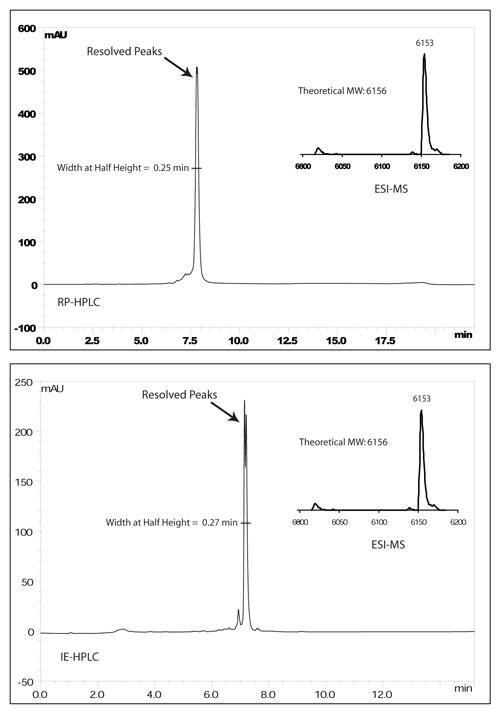Chromatography Profile Analysis of Phosphorothioate Oligonucleotides
Wu Yao, Carlos Martinez
Introduction
The ultimate goal of most antisense research is to develop therapeutic agents for diseases such as diabetes, cancer, and HIV/ AIDS. Phosphorothioate oligonucleotides (commonly referred to as S-oligos) are often the molecules of choice because of their resistance to cellular nuclease degradation. To avoid or minimize toxicity levels in cell or animal work, phosphorothioate oligonucleotides are usually administered with the highest homogeneity possible.
Purification of phosphorothioate oligonucleotides is not without problems, though. The presence of sulfur creates a stereogenic α-phosphorus (Figure 1), and the resulting diastereomers have subtly shifted elution times during chromatography1. This inherent characteristic of phosphorothioate oligonucleotides complicates their analytical HPLC profiles, which are used to determine purity.
In this note, we illustrate how HPLC profiles are affected by incorporating different numbers of phosphorothioate internucleotide linkages into a model oligonucleotide sequence. Analytical techniques employed in this study include reverse-phase HPLC (RP-HPLC), ion exchange HPLC (IE-HPLC), and electrospray ionization mass spectrometry (ESI-MS).

Figure 1.Stereogenic α-phosphorus at one internucleotide linkage. The random R and S configuration results in diastereomers.
Materials and Methods
Oligonucleotide Synthesis
A 20mer oligonucleotide, CATAAGATCAGTCAGGTTAT, was modified with 0, 1, 2, 5, 10, 15, and 19 phosphorothioate internucleotide linkages using standard phosphoramidite chemistry. Following synthesis, crude oligonucleotides were purified on reverse phase cartridges, dried, and analyzed.
Quality Assessment
All oligonucleotides were analyzed by RP-HPLC, IE-HPLC, and ESI-MS using standard QC methods and protocols.
Results and Discussion
The goal of this study was to show how oligonucleotide chromatography profiles are affected by the addition of phosphorothioate internucleotide linkages. The results are shown in Table 1. Although the ESI-MS data indicate that the target product was predominant in all 16 samples, the RP-HPLC and IE-HPLC profiles of each oligonucleotide vary greatly. With the incremental addition of phosphorothioate internucleotide linkages into the model sequence, chromatography peaks start to split and further broaden.
Figure 2, 3, and 4 demonstrate how the RP-HPLC and IE-HPLC profiles differ for S0, S1B, and S10A even though the ESI-MS profiles show that all three were of good purity. S0 had no phosphorothioate internucleotide linkages, therefore both the RP-HPLC and IE-HPLC profiles (Figure 2) show only one sharp peak.

Figure 2.S0 RP-HPLC (top) and IE-HPLC (bottom) data. Inset contains the ESI-MS data for the same sample.
S1B, which contained one phosphorothioate internucleotide linkage, had two possible diastereomers. The RP-HPLC profile shows two partially resolved peaks, which is even more apparent in the IE-HPLC profile (Figure 3).

Figure 3.S1B RP-HPLC (top) and IE-HPLC (bottom) data. Inset contains the ESI-MS data for the same sample.
S10A had ten phosphorothioate internucleotide linkages. In theory, it should have had 1,023 diastereomers present. As observed in (Figure 4), the lack of resolution manifests itself in the form of a broad peak in both the RP-HPLC and IE-HPLC profiles. The retention time for S10A likely increased due to the hydrophobicity of the sulfur atom.

Figure 4.S10A RP-HPLC (top) and IE-HPLC (bottom) data. Inset contains the ESI-MS data for the same sample.
Conclusions
Phosphorothioate internucleotide linkages affect the resolution of oligonucleotide chromatography profiles. Split or broadened product peaks are likely to be observed in analytical RP-HPLC and IE-HPLC profiles due to the presence of diastereomers. In cases like the ones presented in the report, ESI-MS will reveal purity to be equivalent to the area under the observed major HPLC peaks.
References
如要继续阅读,请登录或创建帐户。
暂无帐户?